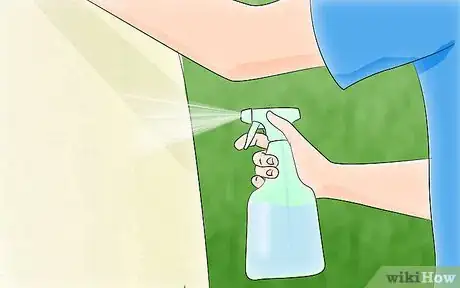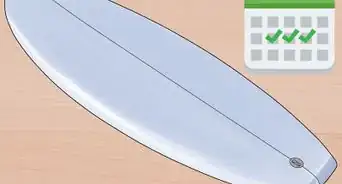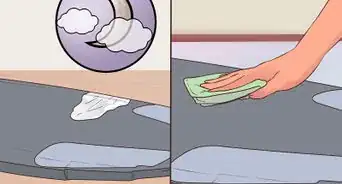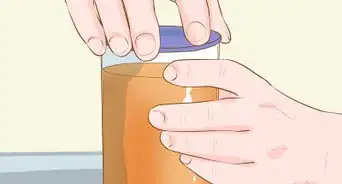wikiHow is a “wiki,” similar to Wikipedia, which means that many of our articles are co-written by multiple authors. To create this article, 29 people, some anonymous, worked to edit and improve it over time.
This article has been viewed 226,697 times.
Learn more...
Wax on a surfboard is essential, providing the surfer with grip and traction. Without wax, a surfer can slip off their board much more easily. For this reason, properly applying wax can be the difference between riding a wave and wiping out. In fact, waxing a board is relatively simple and straightforward. In this article, we'll explain how to put on the right basecoat, follow it with the right topcoat, and then comb it up.
Steps
Applying the Basecoat
-
1Apply your basecoat. If you are using a longboard, wax the entire topside of the board from nose to tail and edge to edge. If you are using a shortboard, wax the topside of the board from the front logo to the back edge (about two thirds of the length) and from edge to edge.[1]
- You can get by just fine without a basecoat wax, but your wax won't last as long. If your board doesn't have the right basecoat, the topcoat won't stick to the board, leaving you with a naked spot on your board where slipping and sliding can happen.
- Your basecoat should stay on the board until you re-wax your board. Your topcoat clings on to the basecoat.
-
2Use any one of several techniques to apply the basecoat. When it comes to getting the basecoat to stick onto the board, surfers tend to use different techniques — sometimes in isolation, sometimes in combination:[2]
- Circle pattern: Rub the wax onto the board in small circles, moving up and down the board until bumps start forming.
- Straight line pattern: Rub the wax onto the board in straight lines up and down the board, parallel to the rocker.
- Crosshatch pattern: Rub the wax onto the board on a diagonal, and then perpendicular to that diagonal, completing a crosshatch pattern.
- Kitchen sink: Rub the wax onto the board in any direction, using any of the patterns listed above or making your own.
Advertisement -
3Apply the basecoat until bumps start to form. Use the edge of the wax stick, not the flat side. Apply until there is a bumpy coat. Your topcoat will adhere to these little bumps. Depending on the size of your board, you may need to use an entire stick of wax, or up to two sticks, in order to get the basecoat right.[3]
Applying the Topcoat and Finishing Up
-
1Apply your temperature wax. Wax over the entirety of the area you just covered with base coat.[4] Rub the edge of the wax onto the board in small, 3 to 6 inch (7.6 to 15.2 cm) circles, or using any of the techniques listed above.
- To be safe, try using a different-colored topcoat wax than your basecoat. If your topcoat wax is the same color as your basecoat it will be harder to tell where you have applied it, so be sure to wax in one direction if this is the case.
-
2Comb the wax. Run your wax comb through the wax on your board. Run the comb in diagonal crosshatch lines to rough up the wax and allow you to grip to your board even better. Be sure to run it through all of the wax on the board.[5]
- Use the wax comb each time you surf if you haven't applied a new topcoat. Sometimes, your wax will get flat and lose some of its traction. If you don't want to apply a new layer of topcoat, take the comb-side of your comb and make a crosshatch pattern using diagonal scrapes.
-
3Spray cool water over the board. This will make the wax harden and stick to the board better. You're officially ready to surf.
Warnings
- Do not apply wax to the bottom of the surfboard.⧼thumbs_response⧽
- Do be cautious when using solvents such as mineral spirits and denatured alcohol.⧼thumbs_response⧽
- Do not apply wax to damaged areas of the surfboard.⧼thumbs_response⧽
Things You'll Need
- Surfboard
- Base coat wax
- Soft, cool, or tropical water wax
- Wax comb
- Plastic scraper (wax combs often have a flat edge that will work fine)
- Wax remover (optional)
- Denatured alcohol (optional)
References
- ↑ http://www.surfscience.com/topics/learn-to-surf/surfing-101/how-to-wax-a-surfboard/
- ↑ http://www.surfscience.com/topics/learn-to-surf/surfing-101/how-to-wax-a-surfboard
- ↑ https://www.surfertoday.com/surfing/how-to-wax-a-surfboard
- ↑ https://www.surfertoday.com/surfing/how-to-wax-a-surfboard
- ↑ https://www.surfline.com/surf-news/properly-wax-surfboard/13823
- ↑ https://www.learntosurf.com/how-to-wax-a-surfboard/
- ↑ http://www.surfinghandbook.com/knowledge/beginners-surfing-tips/surf-wax/
About This Article
To wax a surfboard, start by applying basecoat wax to the topside of it, working in a circular or crosshatch motion. Then, once tiny bumps start to form in the basecoat, switch to a temperature wax. Apply the temperature wax to the entire area you covered with the basecoat, and then run a wax comb through the wax in a crosshatch pattern. Finally, spray some cold water over your board to help the wax harden. For tips on how to choose a temperature wax for your surfboard, scroll down!






























































